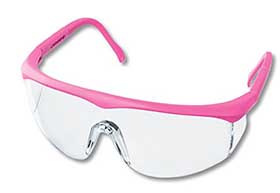Virtual Rat Dissection
Rat External Anatomy
Step 1: In the biology lab, you will be working with specimens that have been preserved in chemicals and you will be working with sharp instruments.
Before you start, obtain safety goggles, and nitrile gloves. Nitrile gloves come in different sizes, most women will wear a medium and most men will wear a large. This can vary though. Try not to waste gloves by choosing the correct size.
Check to see if your station has the equipment you will need to dissect the rat. This includes a dissecting pan, scalpel, scissors, probes, and pins.
Rats are ordered from biological supply companies. They come stored in a preserving fluid, either in bags or in a bucket. Always use latex or nitrile gloves when handling your rat and safety goggles are required to protect your eye from chemical splattering or debris.
The rats do have fur, though they can vary in color. Many lab rats are white, but this does not mean they are albino. Some rats are white with a black stripe, sometimes called "hooded rats." Other rats are dark brown or gray.
These rats are stored in "carosafe" a chemical that keeps them preserved. Over time, rats stored in buckets become bloated with the chemical, use caution when opening the body cavity of these rats as the chemical is prone to spray and splatter. Once an incision is made, the rats can be drained of fluid.
Place your rat in a dissecting tray and examine the external features. The rat (and all vertebrates) has anatomical regions to help locate structures.
cranial region – head | cervical region – neck
pectoral region - area where front legs attach
thoracic region - chest area | abdomen - belly
pelvic region - area where the back legs attach
Virtual Rat Navigation
Step 1: Body Regions
Step 2: External Features
Step 3: Expose the Muscles
Step 4: Expose the Bones
Step 5: Head & Neck
Step 6: Thoracic & Abdomen
Step 7: Urogenital System



